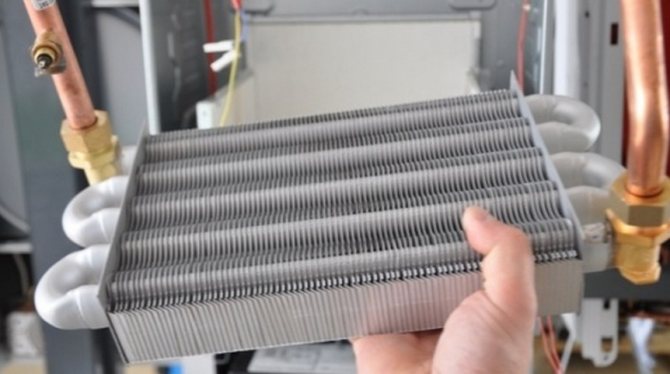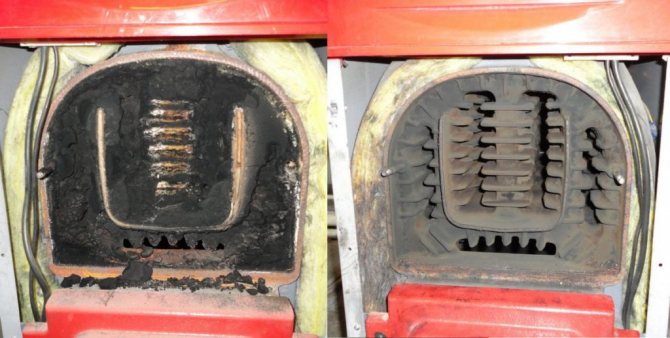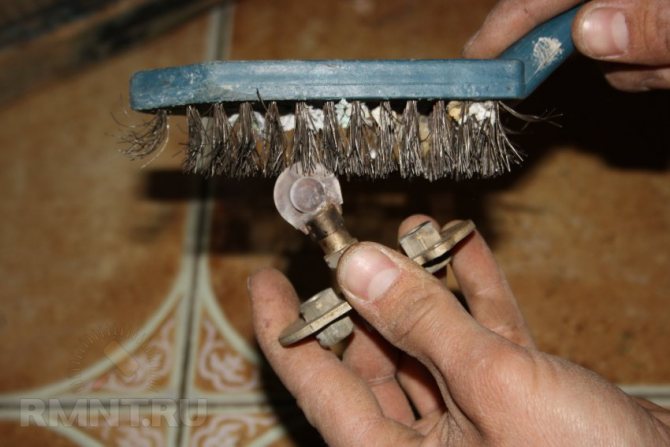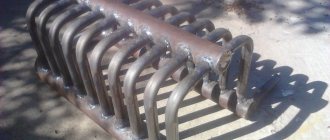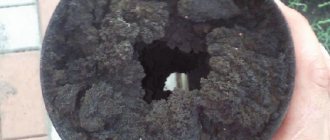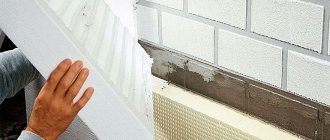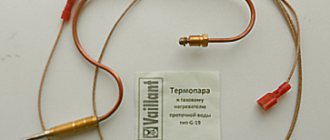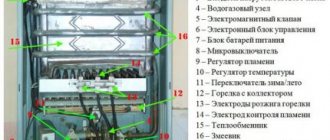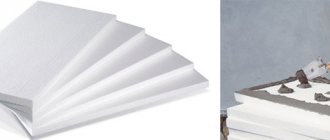Where is the drain filter located
To find the drain filter on the front-loading Ariston washing machine, you need to open the decorative panel at the bottom of the front side. On some models, it can be easily removed by hand, on others it will need to be pry off with a flat screwdriver or other object. Sometimes the unit is closed by a small door that opens easily.
After removing the panel, the consumer will find the drain hose, and next to it the filter cover, which will need to be unscrewed for cleaning.
Similarly, the required part is located in Ariston top-loading washing machines.
Care rules
In order to prevent the appearance of limescale on important components and parts of the washing machine, there are several ways.
Since in the overwhelming majority of cases, the cause of breakdowns lies in the hard water used and the salts it contains, experts advise:
- Add water softeners or ordinary citric acid or Calgon descaler to the drum during washing;
- Soda ash should be added periodically to the water. Its molecules, when combined with the salts contained in the water, will not allow the formation of scale;
- Washing at low or medium temperatures prevents the formation of scale on the heating element. It is better to wash the remaining stains on things by hand, without exposing the car to the danger of breakage;
- It is not recommended to wash old clothes, since the lint and small particles separating from them settle on the walls of the drum and contribute to the appearance of lime deposits on the heater and on the machine components. Such things should be washed by hand or in a special bag;

- It is advisable to pre-soften the water, for which it is recommended to install water softeners at the entrance to the machine;
Following expert advice will help extend the life of your washing machine and prevent plaque and unpleasant odors.
Preparing for cleaning
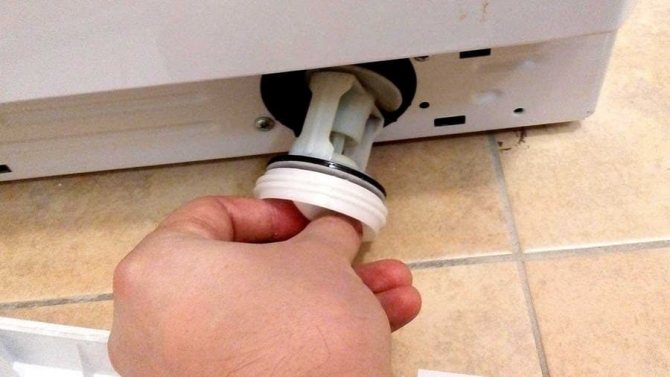

Before starting cleaning, you need to disconnect the Ariston washing machine from the network, water supply and sewerage. If the approach to the equipment is difficult, it will need to be pushed into a place convenient for work.
A small amount of water always remains in the drain system, which will pour out when the filter is unscrewed. Therefore, you need to prepare a low container and dry rags to collect the liquid.
Drain filter cleaning instructions


To clean a clogged unit, you will need to do the following:
- slightly tilt the Ariston washing machine back, put rags and place a container for liquid under it;
- scrolling counterclockwise the filter cover, gently turn until water flows;
- wait until the liquid is completely drained;
- unscrew the knot completely and pull it out;
- first, large debris must be removed from the part: dirt, foreign objects, pieces of fabric, threads, etc.;
- then remove the deposited plaque with a hard sponge, and if it has formed in large quantities, then you can soak the structure in a citric acid solution;
- Rinse the drain filter thoroughly under running warm water.
It is forbidden to use boiling water to wash the part, because it can deform the plastic or damage the sealing gum.
After cleaning, you need to take a flashlight and inspect the landing nest. If you find debris and dirt, you will need to thoroughly clean it with a damp sponge or clean rag.
After cleaning is completed, you should reinstall the filter in its original place.To do this, you need to place it evenly in the socket and screw it in clockwise carefully, avoiding distortions. After that, you can return the Ariston washing machine to its original place, connect to the network and communications and start a test wash to check the device.
Cleaning the filter elements
To carry out the work, you need to prepare the following in advance:
- screwdriver;
- rag or low water container.
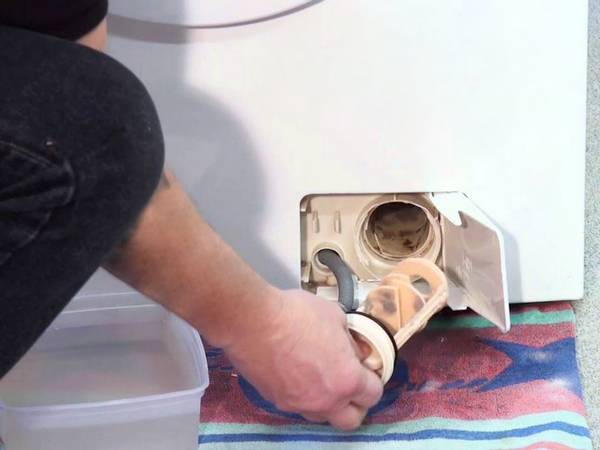

In order to perform filter maintenance, you need to do the following:
- Before starting work, you must disconnect the machine from the power supply.
- It is necessary to shut off the flow of water into the tank.
- On the front side, at the bottom, you can see a bezel that covers the filter. It needs to be removed. It is convenient to use a screwdriver for this. The cover is located on special latches. They can be pry off with a tool and the bezel is released.
- To perform further actions, you need to slightly tilt the washing machine back and put a previously prepared rag under the filter hole. Then the machine is returned to its original position.
- The filter handle must be turned to the left by hand. After that, a little water will be poured onto the prepared rag. The part must be removed from the body.
- You need to carefully inspect the filter and start cleaning it. First, they remove dirt and small objects that are stuck here.
- The part is washed and wiped thoroughly with the hard side of the sponge. If there is a clear plaque on the filter and there is mold, citric acid can be used for cleaning. The filter can be placed in its solution and held for a few minutes, then wiped off with the hard side of the sponge.
- You need to inspect the hole where the filter was and wipe it with a damp sponge. In this case, you should pay attention to the impeller. If threads or hair are wound around it, you need to remove them.
When cleaning is over, the filter is reinserted. It must be tightened carefully, without using excessive force. Otherwise, the threads may be torn off and the parts will have to be replaced.
Do not use hot water for cleaning. Its effect can lead to deterioration of plastic parts.
After the work is completed, you need to check. To do this, the washing machine must be turned on in idle mode. Make sure there is no water leakage.
If it leaks out, then one of the possible reasons is an inaccurately twisted filter. In this case, it must be unscrewed and then carefully reinstalled. Another common cause of leakage is gasket wear. In such a situation, it needs to be replaced.
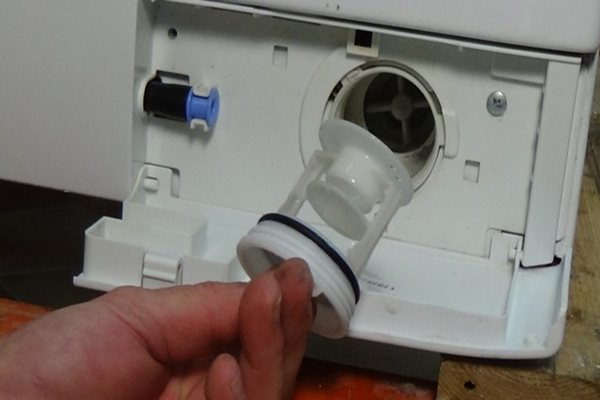

Washing machine maintenance recommendations
The drain filter of the Ariston Margarita 2000 washing machine or another model should be cleaned at least once every two to four months. If the equipment is used daily, for example, in a family with several children, then the device should be serviced every month.
The regularity of cleaning the drain filter is influenced by the type of fabrics that are washed in the machine. So, products made of pile and wool are more often washed in winter and autumn. These materials contain fluff, which quickly and seriously clogs the drain filter, which means you need to clean it more often.
Feather and lint items such as pillows or outerwear will generate a lot of debris and should be cleaned immediately after the end of the program.
Why do you need to clean the washer
Washing machine manufacturers say they have an average lifespan of around ten years. This period is significantly shortened due to the use of too hard water, dust, dirt and other negative factors during washing. One day the machine stops working. This could be due to clogging, limescale build-up, etc.
In order to prevent damage, it is necessary to periodically clean the washer and it is advisable to do this without waiting for visible problems. Experts recommend cleaning the machine at least twice a month.
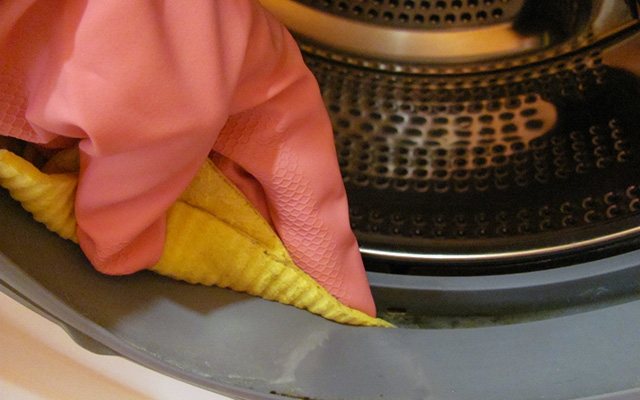

What happens if you do not clean
If you do not service the Hotpoint Ariston washing machine and do not periodically clean the filter, the consequences can be very unpleasant.
- First, there is an unpleasant odor. It comes not only from the Ariston washing machine itself, but also from the linen that was washed in it. This is because the accumulation of debris and dirt leads to the appearance and proliferation of bacteria and germs. As a result of their activity, the mud deposits sour, this leads to the appearance of a stench.
- Secondly, the accumulation of dirt leads to the growth of bacteria and mold. Having filled the Ariston washing machine, they will begin to poison the air in the bathroom or in another room where the device is located. This can lead to serious illness.
- Thirdly, the operation of the drainage system is disrupted due to the formation of blockages. If you do not pay attention to such a breakdown, the part will become completely dirty and as a result, the Ariston washing machine will sooner or later stop draining water during and at the end of washing.
- Fourth, the pump will break or malfunction will occur. Debris can enter the pump from the drain filter. At best, foreign objects will stop the pump from working, at worst, they will damage the impeller or pump housing. You will need to carry out expensive repairs or completely change the unit.
Removing scale
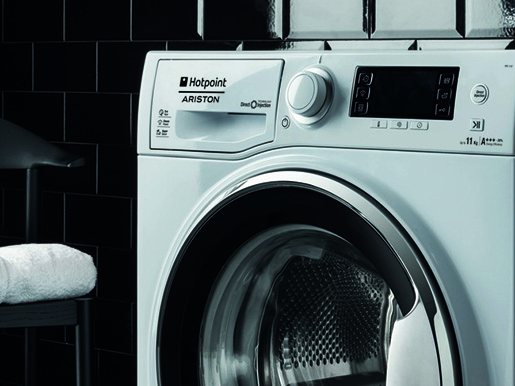

Due to the constant contact of the parts of the washing machine with hard water, a layer of scale forms on them, which only grows over time and interferes with the operation of the unit, resulting in its breakdown. Scale must be fought and the sooner the better.
Before cleaning an Ariston washing machine, or for example, built-in Hotpoint models of machines, you should decide which method will be applied. Many brands of washing machines have an auto-cleaning function that does not require physical effort from the owner. Those who do not have this option will have to clean the unit themselves.
You can remove limescale with citric acid. Therefore, owners of washing machines should always have it at hand. For cleaning, you need about 100-200 grams.
- The tank should be emptied, as cleaning is carried out with a “dry” wash;
- Approximately one hundred to two hundred grams of acid should be poured into the detergent drawer. It is allowed to pour the product directly into the washing drum;
- Washing starts at a temperature of 90 degrees with a long spin;
- During the cleaning wash, pieces of scale will peel off and come out of the machine through the drain system;
- At the end of washing, open the machine and check if there are any lumps of scale in the drum. If left, remove with a rag.


It is advisable to wash things at a temperature of at least 50 degrees - this will save the machine from the appearance of scale in the future, since it does not settle on the parts and assemblies of the washer at this temperature. In addition, this mode is also economical, since the heating element works in a sparing mode. The only negative is that linen can be poorly washed and then you should use a special powder for washing.
Fluffy or old items also tend to build up limescale deposits in the washing machine. Small particles of shabby clothes are separated from things during washing and settle on the insides of the washing machine in the form of a kind of plaque. It is best not to machine wash old and fragile items. This will extend its service life.
If the part cannot be obtained
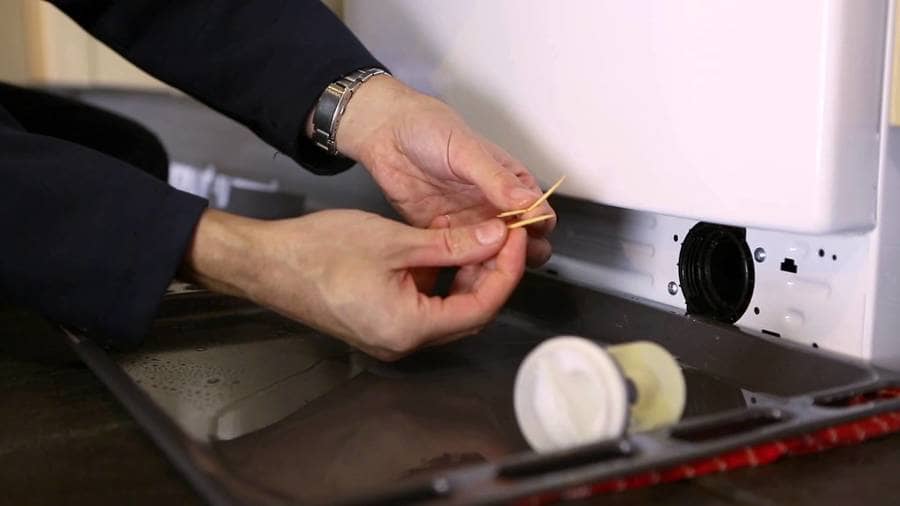

In some cases, it is impossible to remove a clogged unit from the body of the Ariston ARTF 1047 washing machine or another model.The reasons may be different: the knob does not turn or the filter is stuck in the seat and cannot be pulled out. Neglect of the rules of operation of the Ariston washing machine and the lack of regular or periodic cleaning can lead to such consequences.
If the part cannot be unscrewed, this is due to the ingress of a foreign object (for example, a bone from a bra or a button) or the formation of scale between the seal and the thread. You can unscrew the knot with pliers. Be very careful not to break the handle or the filter itself.
If the use of pliers did not help, you will need to remove the pump and only then unscrew and clean the filter.
On different models of Ariston washing machines, remove the back or front panel of the case, then disconnect the wires, unclench the fixing clamps that secure the drain pipe and hose to the pump volute, and then remove the pump connected to the volute. It is easier to clean the drain filter through the drain hole. You can also open the latches or unscrew the screws, disconnect the pump from the volute, and then clean the filter through the pump opening. After processing, it should be easily unscrewed.
The steps to clean the drain filter through the pump are quite complicated, so if you are not sure that the procedure will be performed correctly, it is better to contact the professionals.
In the event that all the actions described above did not bring results and it was not possible to get the part, this means that a mistake was made somewhere or that the Ariston washing machine has some peculiarity. There is no need to break the device, the right solution would be to seek help from professionals.
If the drain filter leaks after cleaning
After the part is cleaned, you will need to check the washing machine for a leak. It should be borne in mind that it may not appear immediately, but only after performing several washings.
There are a number of reasons why a washing machine is leaking.
- The first and main reason is the incorrect installation of the drain filter. It could be screwed in loosely or crookedly. The part must be screwed in without distortions to avoid accidental shifts along the thread. In this case, the element should be tightened tightly, but very carefully. It is worth remembering that with strong pressure when screwing the cover, the threads on the plastic part can be damaged. To eliminate the leak, it is enough to unscrew and reinstall the assembly in its original place, correcting the misalignment and fixing it tightly.
- Secondly, the integrity of the rubber gasket could be compromised, which ensures the tightness of the installation of the drain filter. It could crack during operation or be damaged by careless removal of the part, as well as during careless cleaning with cutting tools. To eliminate such a breakdown, you will need to replace the sealing gum, if available, or install a new drain filter.
- The third reason for filter leakage is damage or thread defect. This could have happened due to improper removal of the part or due to excessive tightening of the lid. As a result, the contact of the drain elements becomes weaker, and therefore a leak appears. To eliminate the breakdown, you will need to replace one or several parts at once, for example, a filter and a snail. If you are not sure that you will be able to perform all the actions correctly, you should seek professional help.
How to clean the oven effectively
- Dry the oven well with a paper towel. Wet the inner walls with soapy water and leave for 15-20 minutes to soak the fat a little. After that, pour a weakly concentrated soap solution into a baking sheet and place it in the oven. Set the temperature to 120 degrees and leave the oven with the door tightly closed for 30 minutes. All impurities will melt and dissolve in the hot steam.After that, the oven must be thoroughly wiped with a soft cloth and rinsed with clean water.
- Soak baking soda or citric acid in water and apply to the damp inside of the oven. Leave it on for 15-25 minutes, depending on the degree of soiling, then dry thoroughly with a paper towel and rinse with water.
- If the contamination is insignificant, then an aqueous solution of vinegar in a 1: 1 ratio will cope with them. Moisten the inner walls with it liberally, turn on the oven at 50 degrees and leave for 15 minutes. Then rinse off any dirt with clean water.
- Such a folk remedy will help to remove more serious pollution. Apply the vinegar solution in the same proportion to the walls of the oven and sprinkle with baking soda. During the reaction of extinguishing soda with vinegar, fat and dried food debris will lag behind the surface. Citric acid can be used in place of vinegar to avoid pungent odors.
- Ammonia also copes well with dirt. Rub it liberally on the inside of the oven, close the door and leave for 10 hours, for example overnight. In the morning, rinse the oven thoroughly with clean water so that the smell of ammonia disappears completely.
- Pour 200 ml of ammonia into a baking sheet and top up with water. Put in the oven for half an hour. All dirt can be easily wiped off with a sponge and soapy water.
- Sprinkle a thick layer of salt over the inside of the oven and let it heat at 100 degrees for 30 minutes. Allow the oven to cool down, sweep out the salt with residual dirt and rinse the surfaces with cold water.
- Make a simple yet highly effective paste: Mix equal parts salt, baking soda and water. Apply the product to the surface that is dirty and let it sit for 10 hours. Then rinse off the residue with cold water.
Many owners of modern gas stoves do not know how to effectively clean a gas stove and what tools are best used for this purpose. The choice of the latter should be treated especially carefully so as not to damage the coating of the stove and to remove all dirt. From this article, we will learn how to clean a gas stove at home, how to clean cast iron grates and gas stove handles, as well as other important parts on which dirt accumulates. Each owner of the device must adhere to certain rules during the cleaning process and follow the sequence of actions.
Before washing the gas stove and cleaning the soiled grate on the gas stove, it is necessary to disconnect the device from the gas supply, as this is required by safety rules. This simple manipulation will prevent accidental gas flow and significantly reduce the risk of possible injury and damage. Then you need to carefully remove the grate
- this part usually accumulates the most contaminants, including greasy deposits, which are especially difficult to remove.
You can clean the gas stove grate using popular folk methods. First, it must be placed in a basin or bathtub filled with hot water and laundry soap. Prepare your soap solution
It is not at all difficult: for this, pieces of 72% soap must be dissolved in 5-7 liters of water. In this case, the grate must be completely immersed in the solution.
The gas stove has special burners and electric ignition, which also accumulate a lot of grease and dirt. If the design of the device allows, they will need to be removed and immersed in a soapy solution along with a grate, where they will remain for several hours. Now it will be much easier to wash the free surface of the slab. First you need to collect food debris and light dirt, which are wiped off with dry sponge with a hard surface
or coarse fabric.
Each stove owner is always worried about how to clean the handles and how to wash these hard-to-reach parts. This will require special cleaning products and some practical skills.If you have an oven, you will need to wash its internal parts and external parts.
You can buy any product suitable for cleaning a gas stove or use folk recipes, which will be discussed below.

